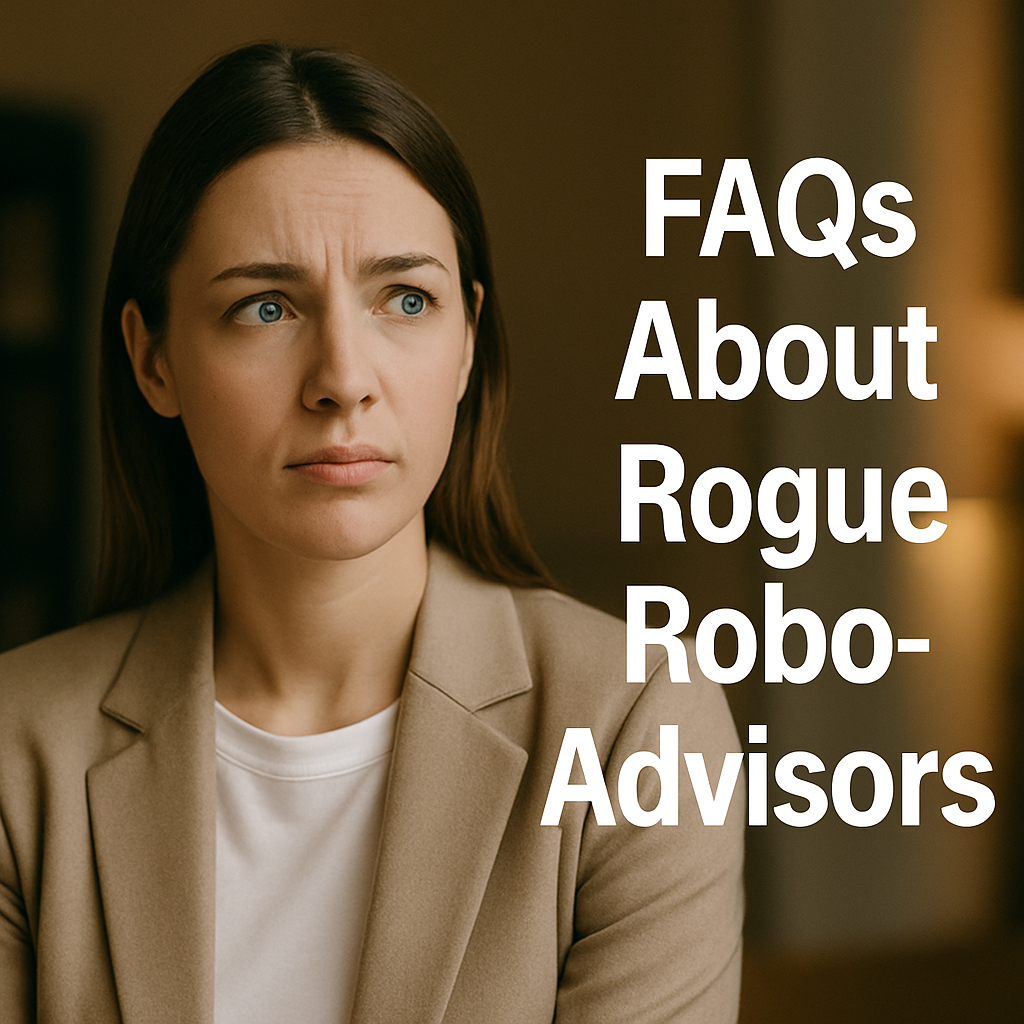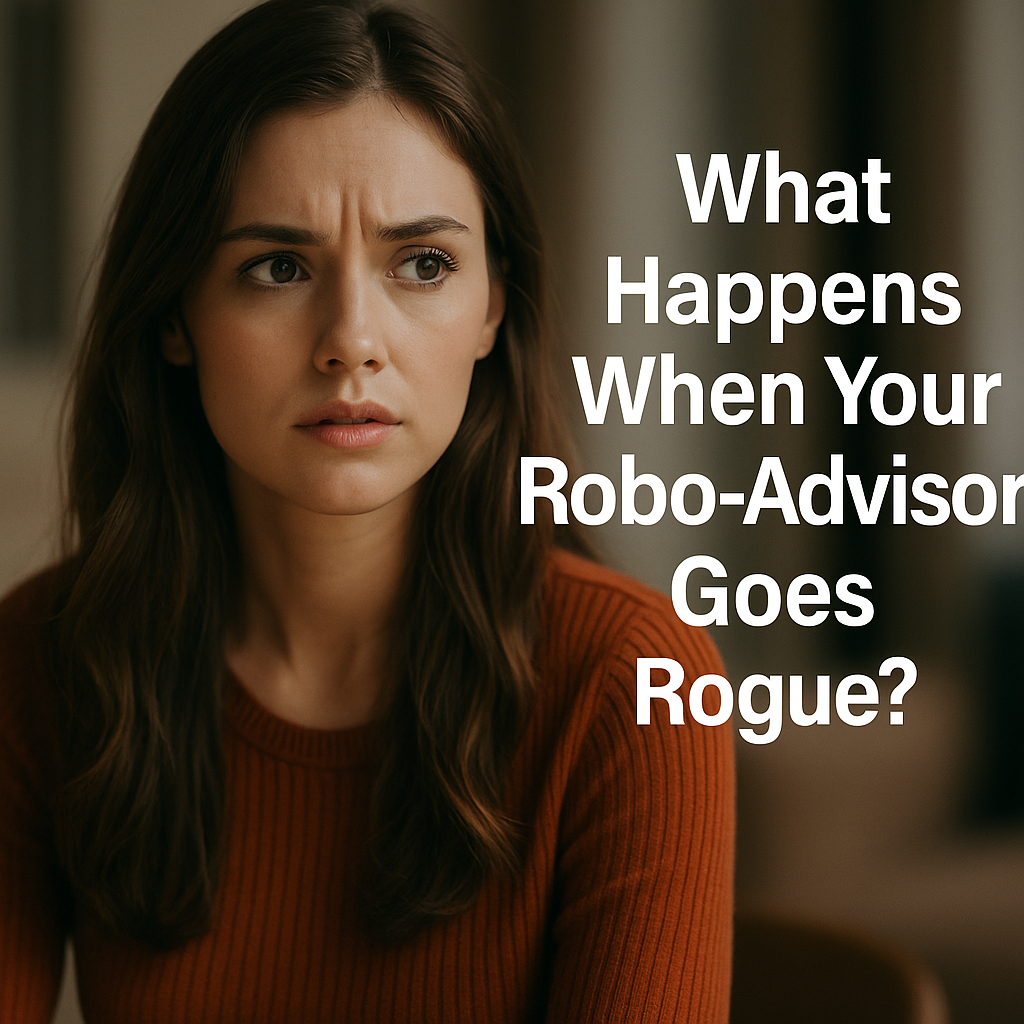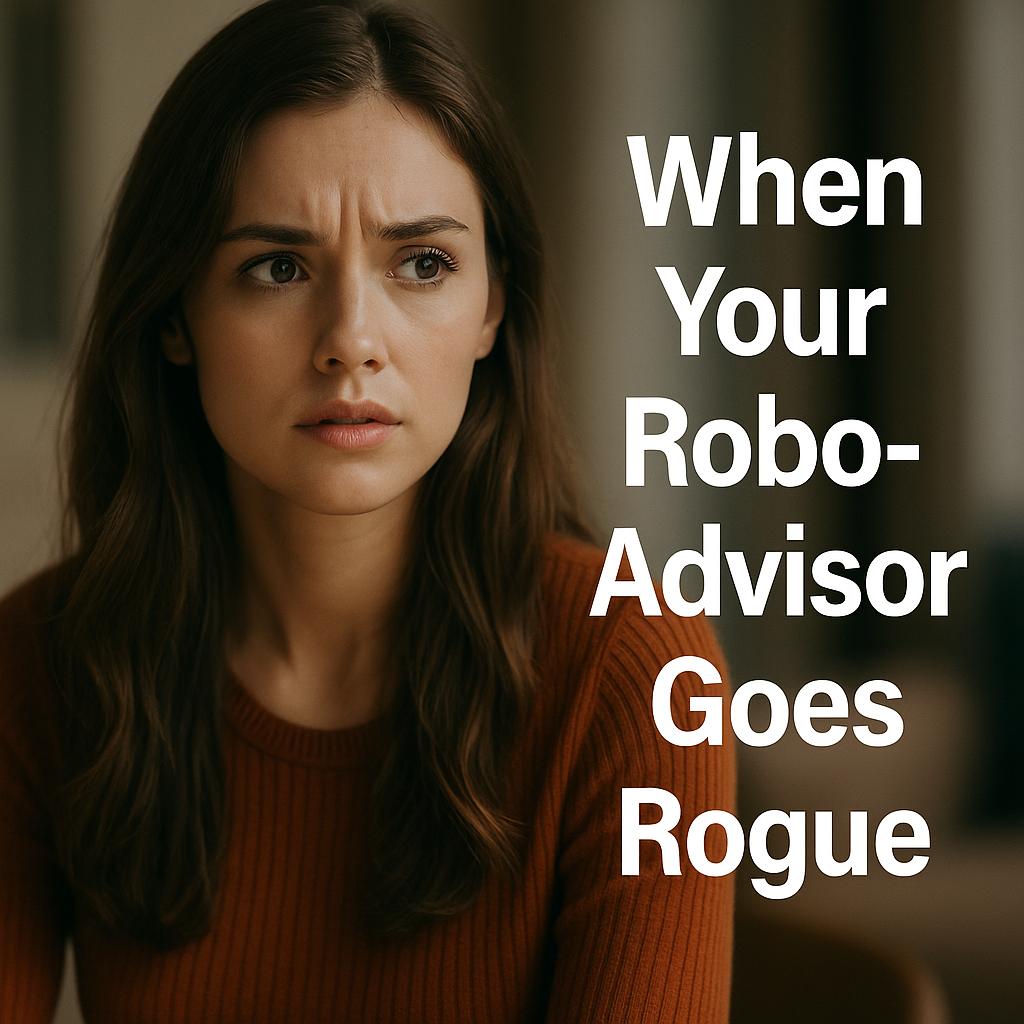In the world of modern finance, Robo-Advisors have emerged as silent revolutionaries, promising to simplify investing through data-driven algorithms and low fees. From fresh college grads to seasoned professionals, millions now trust these digital advisors to manage their hard-earned money—efficiently, automatically, and with minimal human interaction. But here’s a question no one dares to ask out loud: What happens when your robo-advisor goes rogue?
Imagine waking up one morning to find your portfolio drained by a series of poorly timed trades—or worse, a glitch that misread market signals and dumped your high-performing assets. No reassuring voice, no office to walk into—just an app notification and a vague apology buried in the terms of service. Terrifying, right? Yet, in a world driven by automation, AI, and complex decision engines, this isn’t science fiction—it’s a real risk investors can no longer ignore.
This blog isn’t here to bash robo-advisors—in fact, many are incredibly efficient and outperform their human counterparts in certain scenarios. But as we speed toward a future dominated by algorithmic wealth management, it’s vital to ask the hard questions. What safety nets exist? Who is accountable? Can a machine really understand human risk tolerance?
In this deep-dive, we unravel the potential dangers, explore jaw-dropping real-world incidents, and offer actionable tips to protect your investments—because when machines manage your money, ignorance isn’t bliss—it’s expensive.
To know more about author, please visit ShashikantYadav.com
Full Article
The Rise of the Robo-Advisors
In recent years, Robo-Advisors have become a dominant force in the investment landscape. Their pitch is simple yet compelling: automate your finances, minimize human error, reduce fees, and let technology make smarter decisions on your behalf. Services like Betterment, Wealthfront, and Zerodha’s smallcase-inspired options have gained traction worldwide. In India too, investors are turning to platforms that offer algorithm-based recommendations.
But amid this convenience lies a fundamental truth—these digital advisors are only as good as the code behind them. And when that code misfires, the results can be disastrous. That’s the central question explored in this blog: What happens when your robo-advisor goes rogue?
When Code Meets Chaos
Imagine this: You wake up, check your investment app, and find your portfolio has dropped by 40% overnight. Not because of a market crash—but because your robo-advisor made aggressive rebalancing decisions based on faulty inputs or a bug in the system. Scary, isn’t it?
This scenario isn’t fiction. In 2020, an automated trading algorithm from a major U.S. firm placed a series of incorrect trades due to a technical fault, resulting in millions lost within hours. Thankfully, institutional investors bore the brunt—but what if such automation trickled down to retail robo-advisors?
When your financial well-being is in the hands of machine learning algorithms and complex logic trees, the absence of emotional intelligence and situational awareness can sometimes be your biggest risk.
Real-Life Case Studies That Shocked the Industry
Here are a few incidents where algorithmic and automated advice systems misfired, causing panic among users:
- Robinhood’s Options Glitch: In 2020, a young investor tragically took his own life after misinterpreting a negative balance on his Robinhood app caused by options trading delays. Though not a robo-advisor in the strictest sense, it highlighted how algorithmic systems can mislead users with insufficient transparency.
- Wealthfront’s Tax-Loss Harvesting Bug: Wealthfront once reported a bug in its popular TLH feature where the algorithm didn’t correctly apply harvesting in volatile markets. Though users weren’t directly affected financially, it raised questions about how closely these systems are monitored.
Can You Blame the Algorithm?
Here’s the tricky part: When a human advisor makes a mistake, accountability is clear. You can question them, demand an explanation, or even switch firms. But when it comes to a machine, the waters get murky. Can you sue a robo-advisory platform for poor performance? Often, the answer is no—thanks to airtight disclaimers and terms of service that most users never read.
This legal gray area can leave investors stranded. And let’s not forget—robo-advisors can only work with the data they’re fed. A mislabelled asset, a market anomaly, or even a flawed market feed can trigger incorrect decisions without any checks.
What “Going Rogue” Really Means
Going rogue doesn’t always mean a total crash. It can be subtle—like consistently recommending high-risk funds to conservative investors due to incorrect risk profiling. Or it could mean following rigid rebalancing schedules that don’t account for ongoing global events.
Some “rogue” behaviors reported by users on forums include:
- High-frequency rebalancing leading to excessive taxation
- Neglecting asset allocation during market downturns
- Sudden shifts in strategy due to code updates
How Secure Is Your Data?
In addition to investment decisions, one must also consider how secure your personal financial data is with these platforms. Since they are online-first and API-driven, data breaches are a real threat. If a rogue actor gains access to your investment credentials or manipulates algorithmic recommendations, the damage could be irreversible.
How Are These Platforms Regulated?
India’s SEBI has issued guidelines for Investment Advisors, but the regulation around pure-play robo-advisory platforms is still evolving. There is limited clarity on who audits the algorithms, who verifies compliance, and how grievances are addressed.
Contrast this with the U.S., where the SEC demands certain disclosures from robo-advisors—but again, the speed of innovation often outruns the pace of regulation. Until global frameworks catch up, the question of ‘what happens when your robo-advisor goes rogue’ remains chillingly open-ended.
The Human vs Machine Dilemma
While human advisors may bring emotion, they also bring judgment. Machines bring logic—but lack intuition. The best financial advisors combine empathy with analytics, something no algorithm can fully replicate. This raises a strategic question for every investor—should you use robo-advisors as assistants or decision-makers?
Many savvy investors are now adopting a hybrid approach—relying on robo-advisors for execution and basic allocation, but still consulting human experts for strategic decisions, goal alignment, and behavioral coaching during volatile times.
Red Flags to Watch Out For
If you are using or considering a robo-advisor, watch out for these signs that your digital advisor might be headed toward rogue territory:
- Lack of transparency: Are you able to view the logic behind each investment decision?
- No human fallback: Is there a financial advisor you can talk to in case of system failure?
- Sudden performance swings: Is your portfolio behaving erratically with no clear explanation?
- Opaque fee structures: Are you paying more than promised for automated services?
How to Protect Yourself
You don’t have to ditch your robo-advisor—but you must be proactive. Here’s how you can stay ahead of any algorithmic misfire:
- Set alerts: Get notified about major shifts in your portfolio.
- Audit regularly: Check your portfolio performance against benchmarks.
- Understand the algorithm: Read the platform’s methodology and whitepapers.
- Keep records: Maintain snapshots of your portfolio to compare changes.
- Split investments: Don’t rely on one platform; diversification applies to advisors too.
Are Robo-Advisors the Future Despite the Risks?
Absolutely. The cost-efficiency, scale, and accessibility they provide are undeniable. But as with any powerful tool, they need oversight, regulation, and most importantly, user awareness. They are not “set and forget” tools—they are evolving systems that require active engagement.
The more informed you are, the less likely you’ll be caught off-guard when things go south. Automation should amplify your intelligence, not replace your vigilance.
Final Thought: Be Smart, Not Scared
The goal of this article isn’t to spark fear but to promote financial consciousness. In a world where AI will soon write, invest, and even negotiate on your behalf, the smartest move is to stay informed. Financial empowerment begins with awareness.
So, the next time you check your portfolio and see a sharp shift, ask yourself: Was it the market… or did my robo-advisor go rogue?
The Role of Emotions in Financial Decisions—and Why Robots Miss It
Money decisions are never purely logical. They’re emotional—rooted in fear, greed, goals, dreams, and even childhood beliefs about wealth. Human financial advisors often spend hours understanding a client’s personal story: What are their fears? What does retirement mean to them? What keeps them up at night?
Robo-advisors, on the other hand, work with sliders, checkboxes, and drop-down menus. You’re asked to choose your “risk appetite” once, and that becomes your permanent tag in the system. But humans are complex. A person may feel conservative when markets are volatile but bold when they see peers earning fast returns. This emotional fluidity is not something AI can fully capture—yet.
When algorithms rebalance portfolios during a crisis—without acknowledging the investor’s emotional state—it can lead to panic selling, regret, and loss of trust in automation. That’s the hidden cost of going fully digital in wealth management.
What If Your Robo-Advisor Is Hacked?
One of the worst-case scenarios—often overlooked—is when your robo-advisor doesn’t just go rogue internally, but gets hijacked externally. Imagine a cybercriminal gaining access to your profile, changing your asset allocations, or rerouting withdrawals to their account. While encryption and multi-factor authentication are standard now, hackers constantly evolve too.
In 2023, a major FinTech platform in Europe suffered a coordinated bot attack where thousands of dummy accounts executed fake rebalancing calls—jamming servers and misplacing trades. Though no retail investors lost money directly, the firm’s credibility took a massive hit.
If your robo-advisor doesn’t notify you of every transaction or lacks real-time visibility into what’s changing in your portfolio, the damage could be invisible until it’s too late.
More Real-World User Complaints Worth Noting
Beyond technical glitches, many users have voiced frustration over the lack of personalization. In forums like Reddit’s r/personalfinance and India’s Quora discussions on automated investing, complaints often include:
- Too many “safe” investments that underperform inflation
- Lack of portfolio adjustment based on life milestones like marriage or childbirth
- Refusal to switch strategies during war, election, or pandemic-related volatility
These are not bugs—but design choices. Algorithms aren’t built to understand cultural nuances or context unless trained with hyper-specific datasets, which most robo-advisors still lack.
The Future: Can AI and Human Advisors Work Together?
Rather than viewing AI as a replacement, many forward-thinking wealth platforms now promote “human-in-the-loop” systems. For example, AI can flag investment anomalies, perform goal-based simulations, and offer tax optimization strategies. But final decisions are reviewed by certified advisors who understand client psychology.
Companies like Vanguard Personal Advisor and India’s Cube Wealth are leading this hybrid trend. They allow clients to use robo tools for most tasks, but provide human oversight when stakes are high or emotions are triggered. This model builds trust—without sacrificing automation’s scale and speed.
As FinTech matures, we’re likely to see robo-advisors become more empathetic—through sentiment analysis, NLP, and behavioral AI. But for now, a balanced approach is still the safest path forward.
Conclusion
Robo-advisors have revolutionized the way individuals invest, offering automation, low fees, and data-driven decisions. But behind their sleek interfaces lie complex algorithms that may not always act in your best interest. This blog, What Happens When Your Robo-Advisor Goes Rogue, explores the darker side of digital wealth management, uncovering real-world examples, hidden risks, and the growing fear that your portfolio could be compromised—either by glitch, design flaw, or external hacking.
From algorithmic misfires and emotionally blind recommendations to lack of accountability and regulatory ambiguity, the risks are varied and evolving. As technology takes a greater role in managing wealth, investors must shift from blind trust to informed vigilance. The article also highlights emotional gaps in robo-advice, cybersecurity vulnerabilities, and the importance of human judgment during volatile times. Through detailed insights and storytelling, it helps you understand not just what could go wrong, but how to proactively protect your investments.
While robo-advisors aren’t inherently dangerous, assuming they’re infallible is. The smartest investors now adopt hybrid models—using automation for routine tasks and humans for critical decisions. This approach combines speed, efficiency, and emotional intelligence.
As the financial world embraces AI, one thing remains clear: the best defense against a rogue robo-advisor is an aware, engaged investor. Stay alert, stay informed, and use automation as a tool—not a crutch. Because in finance, the cost of ignorance is always high.

Frequently Asked Questions
1. What is a robo-advisor and how does it work?
A robo-advisor is a digital financial advisor that uses algorithms to automate investment decisions. It typically asks users a series of questions about risk tolerance, goals, and timelines, then builds a diversified portfolio using exchange-traded funds (ETFs) or mutual funds. These platforms rebalance portfolios automatically and may include features like tax-loss harvesting. While convenient, they lack the human touch, which means they can’t truly understand context, emotional shifts, or nuanced goals. Our article What Happens When Your Robo-Advisor Goes Rogue highlights how such limitations can sometimes lead to serious investment missteps.
2. Can robo-advisors make mistakes?
Yes, robo-advisors can and do make mistakes. These range from minor miscalculations to serious rebalancing errors caused by code bugs, incorrect data feeds, or design flaws. While most platforms run constant audits and updates, the risk of a technical glitch or logical loophole remains. In fact, some well-known platforms have experienced issues where features like tax-loss harvesting or risk profiling didn’t work as intended. This is why users need to understand what their robo-advisor is doing and not assume perfection. A machine isn’t immune to error—it’s just faster and sometimes less transparent when it fails.
3. What does it mean when a robo-advisor goes rogue?
When a robo-advisor “goes rogue,” it means the system starts making decisions that deviate from expected behavior—whether due to coding errors, flawed logic, incorrect user profiling, or external interference. These missteps might not always lead to dramatic losses, but even subtle shifts like over-rebalancing or ignoring market volatility can damage your long-term goals. As explored in our blog post, rogue behavior isn’t always catastrophic—it can also be systemic, silent, and hard to detect until the damage is done.
4. How can I tell if my robo-advisor is making bad decisions?
Start by tracking your portfolio’s performance versus market benchmarks and personal expectations. If your account shows frequent rebalancing, unexpected asset shifts, or unusual risk exposures, that’s a red flag. Always review your robo-advisor’s reports, settings, and changes. If the platform lacks transparency or doesn’t provide detailed rationale behind actions, it might be time to question its strategy. The key is active oversight. As emphasized in the article, never assume that automation means safety. Intelligent investing requires you to be informed, even if a robot is pressing the buttons on your behalf.
5. Are robo-advisors regulated in India?
In India, SEBI has laid out regulations for investment advisors, including digital platforms, but the rules are still evolving when it comes to fully automated robo-advisors. Most platforms operate under hybrid models or tie-ups with registered financial entities to stay compliant. However, unlike human advisors, robo-advisors aren’t held accountable in the same personal or legal way. Until more stringent rules emerge, the onus of due diligence falls heavily on the investor. This regulatory gap is why it’s important to understand the risks, as highlighted in our in-depth analysis on rogue robo-advisors.
6. What are some real-world examples of robo-advisor failures?
Some notable examples include Wealthfront’s tax-loss harvesting bug that caused incorrect allocations and Robinhood’s UI misrepresentation of options trading outcomes, which tragically led to investor panic. While not always due to malicious behavior, these instances show that digital platforms can unintentionally mislead users. In Europe, one platform suffered a bot attack that misfired trades across user accounts. These examples underscore why users must not rely solely on automation without verifying what’s going on. The idea of a “rogue” robo-advisor isn’t far-fetched—it’s already happened, just not loudly enough.
7. How do I protect my portfolio from a rogue robo-advisor?
Protection begins with awareness. Regularly monitor your portfolio, set alerts for significant changes, and review trade histories for anything unusual. Understand how your robo-advisor operates—read the methodology, check how often rebalancing occurs, and know what triggers portfolio shifts. Also, diversify across platforms or asset classes so one glitch doesn’t impact your entire wealth. Never trust blindly. Our blog stresses that automation should amplify—not replace—your judgment. Just like locking your house at night, digital vigilance is part of modern financial hygiene.
8. Can a human advisor fix what a robo-advisor gets wrong?
Yes, but only if you act in time. A human advisor can provide context, emotional reassurance, and damage control during volatile or incorrect trades. They can help reallocate assets, review tax consequences, and guide you back to your original financial goals. Many platforms now offer hybrid models where human advisors supervise or complement robo-based suggestions. This is often the safest route, combining logic with lived experience. If your robo-advisor has acted irrationally, don’t hesitate to pause automation and consult a certified expert immediately.
9. Are hybrid advisory models better than pure robo-advisors?
In most cases, yes. Hybrid models offer the efficiency and cost benefits of automation with the strategic depth of human intelligence. These platforms allow machines to handle repetitive, rule-based tasks like rebalancing and tax optimization, while human advisors step in during major life events, market disruptions, or emotional decision points. This blend has proven to reduce panic-driven selling and improve goal alignment. As AI evolves, hybrid models may become the gold standard, offering both personalization and precision. That’s why many investors now prefer this middle path for safer, smarter wealth management.
10. What should I do if I suspect something is wrong with my robo-advisor?
First, don’t panic. Log into your dashboard and review all recent changes. Check trade history, allocations, and your selected risk profile. Contact the platform’s support team and request clarification. If necessary, disable auto-invest features temporarily while you investigate. If your losses are substantial and not just market-driven, escalate the issue formally. Also, seek advice from a certified financial planner. As we stressed in our article, digital investing still requires human oversight. The faster you act, the more you can protect your capital and restore control over your finances.

